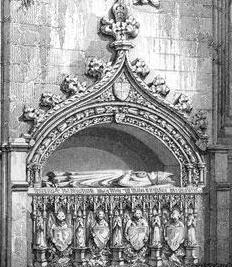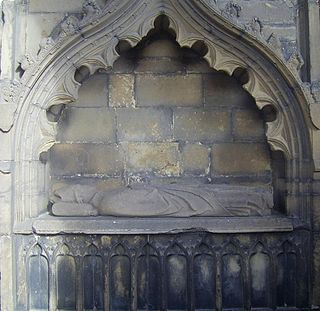Related Research Articles

Robert de Cardeny was a late 14th and early 15th century Scottish cleric. He was the son of one John Cardeny, and brother of the royal mistress Mariota de Cardeny. His early career is obscure. In 1378–80, King Robert II of Scotland petitioned the Pope for a canonry in the diocese of Moray for one Robert de Cardun, despite the fact that the latter already held canonries and prebends in the diocese of Dunblane and Dunkeld. This Robert de Cardun was both a member of King Robert's household and a student at the University of Paris. Robert had graduated from Paris in 1381 as Licentiate. In 1392 he was a receiver of the "English Nation" at Paris and custodian of the Nation's seal. In 1394 Robert was still in Paris, now as Master Robert de Cardeny
John de Ralston was a 15th-century Scottish bishop and administrator. He was regarded as illegitimate, although today his parents are not known. Ralston appears in the records for the first time in 1426, where he is chaplain and secretary to Archibald Douglas, 5th Earl of Douglas. He retained this position on the death of Douglas in 1439. Between 1429 and 1443 he served as the fourth provost of Bothwell Collegiate Church, the home church of the Douglas earls. On 26 November 1445 he became dean of the diocese of Dunkeld.
James Livingston was a 15th-century cleric from East Lothian in south-eastern Scotland. Born at an unknown date in the 15th century, he was a son of the Laird of Saltcoats. He chose a career in the church, and became rector of the churches of Forteviot and Weme, and vicar of Innerleithen. By 1474, if not earlier, he had become dean for the whole diocese of Dunkeld. After the death of Thomas Lauder, Livingston was chosen as his successor as Bishop of Dunkeld. Although Livingston's appointment was contested at Rome by Thomas Spens, Bishop of Aberdeen, who wanted to be translated to Dunkeld, Livingston was consecrated on 30 June 1476. Livingston's episcopate is relatively obscure; he spent a good deal of time in Edinburgh, where he is witness to several charters. He died at Edinburgh, on 28 August 1483. He was buried in Inchcolm.
Alexander Inglis was a Scottish cleric and royal clerk. He was the son of one George Inglis and his wife Margeret. At some point in his life he had attended university and obtained a Licentiate in Decrees. In 1477 he became Dean of the diocese of Dunkeld, and in 1480 became Archdeacon of St Andrews. On 17 September 1483, after the death of Bishop James Livingston, he was elected to succeed the latter as Bishop of Dunkeld. Inglis ran into difficulty on 22 October, when the Chancellor of the diocese of Aberdeen, George Brown, was also provided as Bishop of Dunkeld. Inglis was styled Bishop-elect in Scotland until 1485, but on 13 June 1484, Brown had been consecrated at the Papal see. Inglis continued to hold his previous posts as Archdeacon and Dean until his death in 1496.
George Brown was a late 15th-century and early 16th-century Scottish churchman. He first appears on record in 1478 as the rector of the church of Tyningham, and is called a clerk of the diocese of Brechin. In 1482, he was selected to be Chancellor of the diocese of Aberdeen.

Andrew Stewart was a 16th-century Scottish noble and cleric. He was a legitimate son of John Stewart, 1st Earl of Atholl and Eleanor Sinclair, daughter of William Sinclair, Earl of Orkney. His paternal grandmother was Joan Beaufort, former queen-consort of Scotland. Andrew chose an ecclesiastical career, held a canonry in Dunkeld Cathedral and was rector of Blair parish church, a church under the control of the earls of Atholl.

Robert Cockburn was a 16th-century Scottish diplomat and cleric.
Donald Campbell was a 16th-century Scottish noble and churchman. He was the son of Archibald Campbell, 2nd Earl of Argyll and Elizabeth Stewart, daughter of John Stewart, 1st Earl of Lennox. From 1522, he was a student of St Salvator's College, at the University of St Andrews. After graduation, he became a cleric in his home diocese, the diocese of Argyll.
Robert Crichton was a 16th-century Scottish Catholic cleric.

Alexander de Kininmund was a 14th-century Scottish cleric. Although it is not known which one, it is known that in his youth he went to university and achieved a Licentiate in the Arts.
Ingram Lindsay [Ingeram de Lindesay], Doctor in Canon Law, was a 15th-century Scottish cleric. Despite being of illegitimate birth - one of several sons of an unmarried nobleman and an unmarried woman - he nevertheless managed in the end to pursue a successful ecclesiastical career.
Alexander de Kininmund was a 14th-century Scottish churchman. The first mention of Alexander occurs when, as a canon of Dunkeld he is one of three ambassadors sent by King Robert I of Scotland to Avignon in 1320. The purpose of this embassy was to present a letter to Pope John XXII known as the Declaration of Arbroath. As a papal chaplain and lawyer, he was well qualified to argue the Scottish cause, and Barrow makes a strong case that he was, in fact the author of the document.

John de Winchester was a 15th-century English cleric who distinguished himself as an administrator and bishop in Scotland. Winchester was a student of canon law from 1418, graduating with a bachelorate in 1421.

Archibald was a Scottish prelate best known for involvement in a dispute with the Pope.
William de Spynie was a Scottish prelate. He was a canon of Moray by 1363 and Precentor (Chanter) of Aberdeen in 1371. By 1372 x 1373, he had exchanged the latter position with William Boyl for the Precentorship of Moray. He had become Dean of Aberdeen by 1388. It is possible he had become Dean of Dunkeld in 1397, though this may be a mistake in the source, "Aberdeen" rather than "Dunkeld" being meant. At any rate, in that year he was elected as the Bishop of Moray. He travelled to France and on September 1397 was consecrated as Bishop.
Alexander Bur was a 14th-century Scottish cleric. It is highly possible that Bur came from somewhere in or around Aberdeenshire, although that is not certain and is only based on the knowledge that Aberdeenshire is where other people bearing his surname come from in this period. He entered the service of King David II of Scotland sometime after 1343, perhaps as a member of David's exiled court at Château Gaillard. Although Alexander by this point in time already held prebends in both the bishopric of Aberdeen and the bishopric of Dunkeld, on that date King David petitioned Pope Clement VI for another canonry in the bishopric of Moray. Alexander had become a royal clerk and had obtained a Licentiate in Canon Law by 1350. By the latter date, upon the death of Adam Penny, Archdeacon of Moray, Alexander himself became Archdeacon.
Alexander Vaus [Vause, de Vaus] was a late 14th century and 15th century Scottish prelate. Said to have been the younger son of one Patrick Vaus, he apparently held "church livings" in Galloway as early as 1421.
Laurence de Ergadia was a thirteenth-century Scottish bishop. Probably from the MacDougall kindred of Argyll, Laurence had become a Dominican friar and presumably university graduate before being elected Bishop of Argyll, an election which took place sometime between 1262 and 1264. Although the election was quashed by the Pope in 1264, the Pope gave him a fresh provision to the bishopric. Laurence appears intermittently in the records during his three and a half decade episcopate, but his activities in his own diocese are badly recorded. He died as Bishop of Argyll sometime in either 1299 or 1300.
Fionnlagh MacCailein or Finlay Colini was a medieval Scottish bishop. Both his early life and the details of his career as Bishop of Dunblane are not well known, however it is known that he held the latter bishopric between 1403 and his death in 1419. He was part of the circle of Robert Stewart, Duke of Albany, and was one of the many clerics from west and central Gaelic-speaking Scotland who benefited from the latter's patronage. He is said to have authorised the construction of the first bridge over the river Allan at Dunblane.
Dúghall of Lorne [or de Ergadia] was a late 14th century and early 15th century prelate in the Kingdom of Scotland. Probably a MacDúghaill (MacDougall) from the province of Lorne in Argyll, he appears to have studied at the University of Oxford before returning to Scotland for an ecclesiastical and administrative career. He obtained benefices in the diocese of Argyll, Dunkeld, Dunblane and St Andrews, and acted as the secretary and chaplain of Robert Stewart, Earl of Fife, before becoming Bishop of Dunblane. He held the bishopric of Dunblane until his death in 1403.
References
- Dowden, John, The Bishops of Scotland, ed. J. Maitland Thomson, (Glasgow, 1912)
- Myln, Alexander, Vitae Dunkeldensis ecclesiae episcoporum, ed. Thomas Thomson, rev. edn, 1, rev. Cosmo Innes, (Bannatyne Club, 1831)
- Watt, D. E. R., Fasti Ecclesiae Scoticanae Medii Aevi ad annum 1638, 2nd Draft, (St Andrews, 1969)